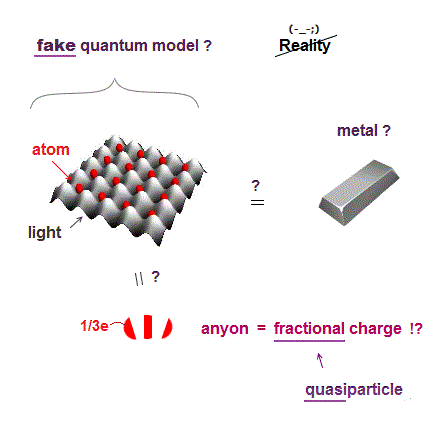
Home page
X-ray, Cryo-EM are useless
fake multi-probe AFM
(Fig.1) Today's useless atomic force (or scanning tunneling ) microscope with just one probe tip can only see (useless) planar flat molecules. Only multi-probe microscope can observe and manipulate various 3-dimensional (= 3D ) molecules.

In 1980s, atomic force (and scanning tunneling ) microscopes (with only one probe tip ) for observing and manipulating single atoms were invented.
In 2000s, Quartz (= qPlus ) sensors, which are much more sensitive with better-atomic-resolution and easier to handle (= without bulky optical instruments ) than the conventional bulky light deflection cantilevers, were started to be used for atomic force microscopes (= AFM ) manipulating single atoms ( this or this p.4-qPlus sensor, this p.7-left-3rd-paragraph, this-3rd-paragraph, this-2nd-paragraph ).
But even now in 2025, today's atomic force microscopes (= AFM ) remain stuck in only one useless probe tip ( this Fig.2, this-p.2 ), which is useless, unable to manipulate various 3-dimensional (= 3D ) atoms or molecules (= today's one-probe AFM can observe only flat small molecules such as benzenes, this p.4 ).
We can know any 3-dimensional molecular structures by using the practical multi-probe atomic force microscopes, which can touch and know the target molecular atomic structures from various different angles by rotating them (= while one probe holds down the target molecule, the other probe can touch and investigate the molecular atomic structures stably ).
↑ Atomic force microscope with only one probe moves and rotates target molecules unstably (= cannot know the exact 3D-molecular structures ) when one probe touches the molecules.
The problem is that using the useful multiple probes is Not included as options to see 3-dimensional molecules at atomic resolution, as shown in this or this-p.12-3D molecules ( today's multi-probe microscopes are used only for observing objects larger than atoms ).
Because the unphysical quantum mechanical atomic model lacking real atomic shape is useless, too time-consuming to dead with the 3-dimensional rotated molecules.
Even this most sensitive atomic force microscope based on quartz-sensor has Not changed its shape nor quality with No progress for more than 16 years since it was first used in 2000s. ← Atomic manipulation nano-technology is deadend for a long time.
Almost all the present atomic force microscopes are used in biological researches just vaguely seeing cells or something, which No longer see single atoms ( this p.6 ) due to scientists intentionally refusing to make useful multi-probe atomic force microscopes for 40 years just to protect the old useless quantum mechanical atomic model.
↑ Today's atomic nano-technology is regressing.
In fact, we already have the technology of making practical multi-probe atomic force microscopes (= with sensitive quartz sensors ) that will need the simple practical realistic atomic model with shapes measured by experiments (= treating atoms like the ordinary macroscopic parts ) instead of the impractical time-consuming quantum mechanical methods, to express various-sized molecules and proteins at the atomic level.
So we should immediately develop and make the useful atomic force microscopes with multiple probes freely manipulating single atoms and molecules (= this technology already exists, but has been intentionally ignored ) to clarify the detailed atomic mechanisms of proteins, biological reactions and cure diseases.
(Fig.1') Surprisingly, No scientists tried to make multi-probe atomic force microscopes manipulating single molecules, though they already had the technology.
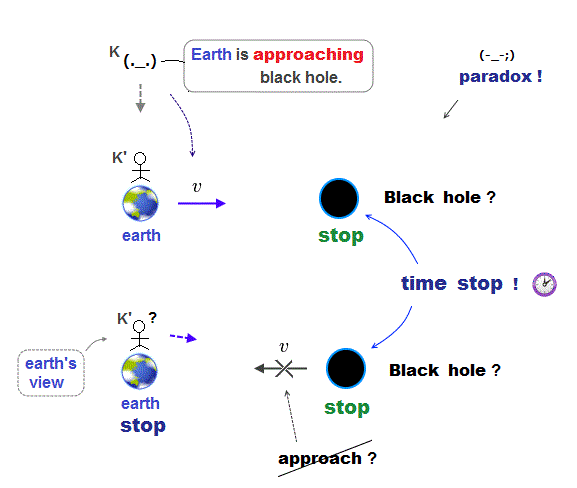
Just to protect the old useless quantum mechanical atomic model such as fictional quasiparticles and one-pseudo-electron DFT, scientists have intentionally avoided making useful multi-probe atomic force microscopes manipulating single atoms or molecules for 40 years.
So the present (fake) multi-probe atomic force microscopes (= AFM ) are used only for measuring electric conductance between multiple probes, or touching objects or cells bigger than single molecules ( this-cell's electrical signal, this-nanowire, this-p.18(or p.7)-p.19 ).
This-p.1-abstract, p.3-3.3 says they just vaguely measured interaction between two probes instead of measuring single atoms or molecules.
Surprisingly, No scientists tried to make multi-probe atomic force microscopes manipulating single atoms, though they already had the technology.
This or this-p.12-3D molecules section made No mention of making multi-probe atomic force microscopes as solutions to visualizing 3D molecules (← They do Not even try to do it ).
↑ This is in stark contrast to today's physics wasting too much time and money only for the hopeless (overhyped) quantum computers and information that are impractical forever.
(Fig.2) Today's technology can easily prepare sharp probe tips (= cone angle is less than 30o, which is sharp enough to make multiple probe tips ) to which only one atom (= such as a CO molecule, a Cu atom ) is attached, which can precisely manipulate single atoms and build molecular devices.
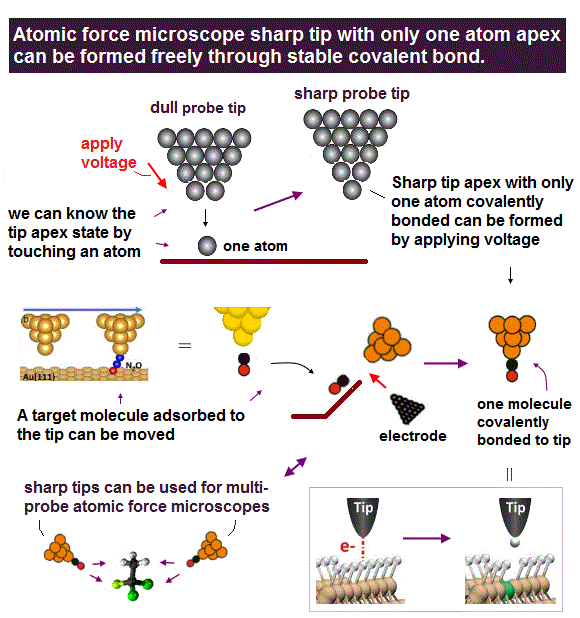
Today's technology can easily make sharp probe tips with cone angle of less than 30 degree, less than 1nm tip radius ( this p.3-Methods, this p.2-last-paragraph, this 8th-paragraph, this-typical spike radius ) whose apex has only one atom such as a CO molecule and a Cu atom.
When the cone angle of the microscope tip is sharp enough or less than 90 degree (= which is possible even without the CO sharper molecular tip ), more than 4 multiple probe tips can be used to touch and investigate a single atom or a molecule at the same time, which means we already have the technology of making useful multi-probe atomic force microscopes.
↑ If we use flat molecules as probe tips, these multiple probes consisting of flat molecular tips (= cone angles less than 180 degree is OK ) can easily avoid colliding with floors.
↑ If we put the target protein onto the slightly elevated floor or sharp molecular floor, we can touch and investigate wider area over the protein by using multiple probes.
We can attach or adsorb a sharp CO molecule to the apex of a single metallic atom which can be easily prepared by poking probe tips into metallic atoms ( this p.1-last-paragraph~p.2, this p.6-left-method-2nd-paragraph ).
↑ These mono-atomically sharp tips or CO-tips, which are already-existing technologies, are robust enough to manipulate target atoms and molecules ( this p.1-abstract-last, p.2~4 ).
By applying voltage through electrodes, today's atomic force microscopes can form artificial molecular bonds (and bond breakage ), which can be used for making various probe tips with desired atoms or molecules attached ( this p.4-5, this or this-p.17-19, this p.2,p.5-left ).
Whether only one single atom is attached to the apex of a probe tip or not can be easily confirmed by touching the probe tip to a target CO molecule attached to the floor substrate, which is called carbon monoxide front atom identification (= COFI, this p.2, this p.3-right ), as shown in Fig.2-right-lower.
This p.9-methods-3rd-paragraph says
"Before we functionalized the tip apex with CO, we prepared metal tips ending in a single Cu atom by repeated
indentations between 300 pm and 1 nm into the Cu surface. Afterwards, we characterized the tip with the
Carbon-Monoxide-Front-Atom-Identification (COFI) method, and repeated the process of tip poking and
COFI characterization until we obtained the COFI portrait of a single-atom metal tip"
Atomic force microscopes with multiple probe tips, which need the tip conical angle shaper (= smaller ) than 90o, can be easily made by today's already-existing technology.
Physicists use only big qPlus quartz sensors that are easy to handle, because the quartz sensors are so sensitive that they do not need to make quartz sensors smaller to detect single atoms ( this p.11-13 ).
As shown in quartz crystal microbalance (= QCM ), the smaller and thinner quartz sensors are more sensitive with higher resonator fundamental frequency ( this-p.4-last-paragraph, this-p.2-right-3rd-paragraph, p.3-right-last-paragraph, this-p.2-2nd-paragraph ).
This p.3-left-last-paragraph says
"Therefore, thinning the
(quartz) oscillator significantly improves the sensitivity of
QCM ( this-p.3-1st-paragraph )"
So we can use the smaller, more sensitive quartz sensors suitable for multiple probe tips of atomic force microscopes.
Atomic force microscope with the quartz tip can touch a single atom and measure small electric current as a scanning tunneling microscope at the same time.
↑ So if we demarcate the floor or substrate (= under target atoms or molecules ) by flowing different patterns of oscillating electric currents in different coordinates, we can easily know the precise position of each probe tip that touches the conducting floor and measures the different electric current's patterns.
(Fig.3) We should use the simpler practical atomic model with shapes which can be easily measured by today's atomic force microscopes as Pauli repulsion, instead of wasting time in useless, time-consuming quantum mechanical model.
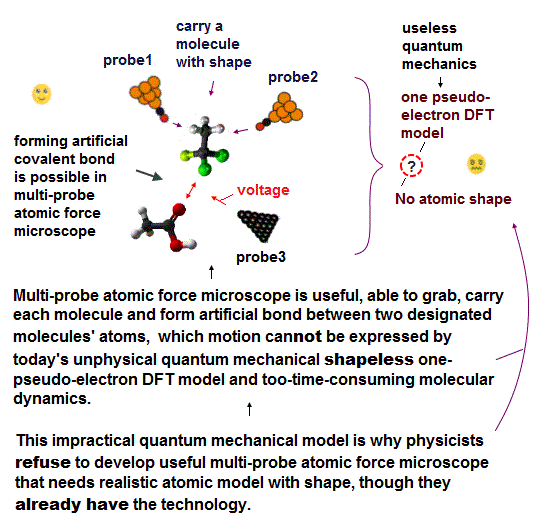
Today's atomic force microscopes can easily and precisely measure each atomic and molecular shape as Pauli repulsion or weak van der Waals attraction ( this p.4, this p.4-8, this p.33-45 ).
So we should be able to treat each atom and molecule with known (= measurable ) shape as a real object or part with shape to clarify molecular mechanisms and design molecular devices by using practical multi-probe atomic force microscopes.
The current mainstream old unphysical quantum mechanical models such as Schrödinger equation and density functional theory (= DFT or Kohn-Sham KS theory ) unable to describe each atom as a real atomic object with shape have to rely on extremely time-consuming methods of integrating artificially-chosen (fake) wavefunctions with many freely-adjustable parameters, which is useless, unable to predict anything.
This p.20-last-paragraph says
"KS DFT is Not an ab initio theory (= DFT is just empirical, unable to predict anything, like the useless Schrodinger equations unsolvable for any multi-electron atoms ), because it does
not approach the exact solution"
↑ To protect this current too-time-consuming impractical quantum mechanical models lacking real atomic shape such as DFT, MD ( this-p.9-12 ), academia intentionally hampers developing the useful multi-probe atomic force microscopes that will make the useless quantum mechanics unnecessary and obsolete.
(Fig.3') Today's atomic force microscope with only one probe tip cannot see 3-dimensional (= 3D ) molecule, so useless.
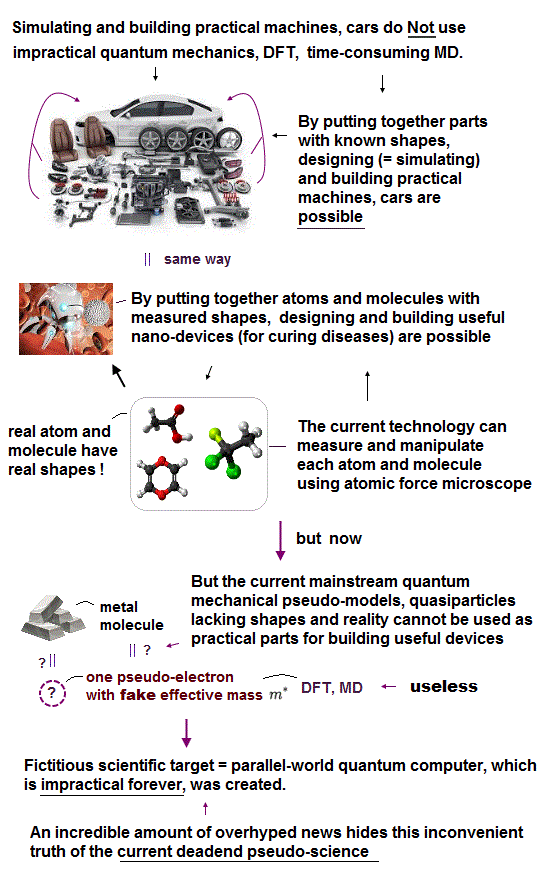
Atomic force microscopes manipulating single atoms have had only one useless probe tip for 40 years with No progress.
This current atomic force microscope with only one probe cannot see 3-dimensional (= 3D ) molecules ( this-lower-challenges, this or this-p.12-3D molecules ), because the target molecule pushed by one probe is easily moved or rotated unstably, which cannot get clear atomic structures.
So today's medical researches use only (useless) atomic force microscopes with dull probe tips that can vaguely see only cells and objects far bigger than single atoms ( this-figure1 ) = cannot see individual atoms.
Only atomic force microscopes with multiple single-atomic probe tips can see 3D atomic structures by one probe fixing the target molecule stably while another probe touching and seeing atoms.
↑ A whole molecule is often rotated around some rotation axis when pushed by a probe tip.
↑ Quantum mechanics treating all molecules as one-pseudo-electron (= DFT, quasiparticle ) model lacking atomic shape can Not express these molecules rotated by probe tips.
In order to describe molecules rotated by probe tips, we have to define the shape and rotation axis of the whole rotatable molecule, which is impossible in the unreal quantum mechanical shapeless atomic model.
↑ So today's (useless) atomic force microscope with only one probe tip can only see flat static molecules such as benzenes or only upper parts of stably-fixed molecules ( this-p.4-p.5, this-p.2 ).
To protect this useless old quantum mechanical atomic model, academia has intentionally hampered making useful multi-probe atomic force microscopes (= which have to treat molecules as real rotatable objects with shapes without unreal quantum mechanics ), though we already have that technology (using sensitive quartz sensor, this-p.7-9 ).
We should use actual atomic shapes obtained by experiments to develop nano-technology, which is hampered by the unreal quantum mechanical shapeless atomic wavefunctions.
(Fig.3'') Quantum mechanics is useless, too time-consuming.
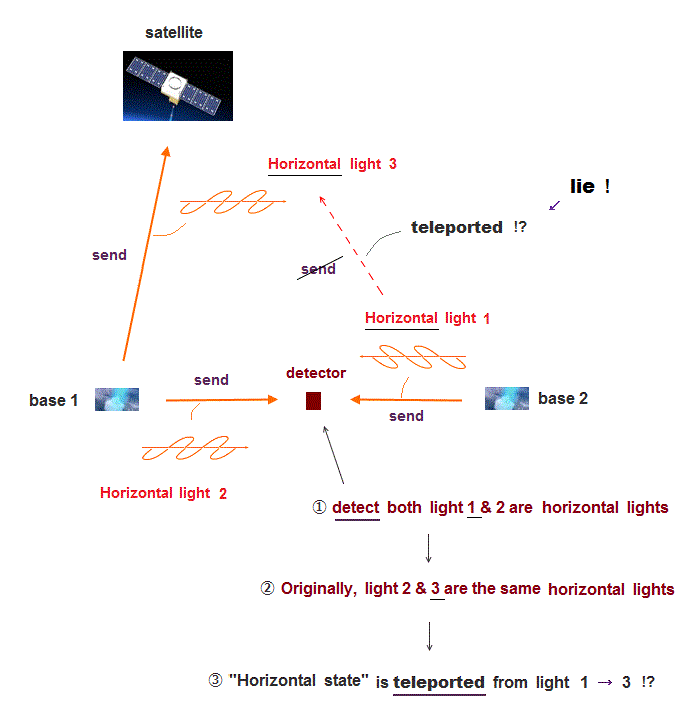
Quantum mechanics has to artificially choose one-pseudo-electron DFT wavefunctions (= ψ ) expressing the whole molecules and probes' atoms (= these shapeless wavefunctions hamper science ), and integrate them to get fake total energy.
And they differentiate the energy equation with respect to coefficient parameters (= c ) of the chosen wavefunction or basis sets ( this-p.5 ) to find coefficients that give the lowest (fake) atomic energy within the chosen wavafunction in variational method ( this-p.5-5 ).
They have to repeat this extremely time-consuming quantum mechanical methods of integrating and differentiating the DFT energy equations until the coefficient parameters luckily converge to some values, which old inefficient method is called self-consistent-field (= SCF, this-p.9, this-p.2-p.8, this-p.6-p.18, this-p.3 ) iteration hampering science.
The present extremely-time-consuming impractical quantum mechanical SCF (= self-consistent-field ) iterative calculations repeatedly updating the chosen (fake) wavefunctions' coefficient parameters often fail to get the converged parameters of the chosen fake wavefunctions (= so No atomic energy E is obtained by this impractical quantum mechanics ).
This-lower SCF convergence says
"Conventional electronic-structure-theory-based methods like DFT rely on a self-consistent-field (SCF) process, where an initial guess for the electron density is generated and then iteratively refined through repeated computation of electron–electron repulsion. This process frequently exhibits chaotic behavior, and SCF convergence can become extremely time-consuming or even impossible."
For the unphysical quantum mechanical shapeless atomic model to explain the interaction between the molecule and atomic force microscope's probe tip, they have to repeat this extremely time-consuming SCF energy calculations by choosing different fake wavefunctions (= and repeatedly updating their coefficients parameters until they converge ) in many different positions (= A, B, C, D ) of the atoms of the molecule and the tip.
↑ This impractically time-consuming repeated SCF energy calculations by choosing many different wavefunctions (+ repeatedly updating parameters ) in many different atomic or tip's positions to compare (fake) energies E in different tip's positions is called geometry optimization ( this-last-calculation method ) or relaxation ( this-p.27-53, this-p.3, this-p.18, this-p.6-2nd-paragraph ).
↑ This quantum mechanical time-consuming geometry optimization just artificially choosing fake electron wavefunctions can Not predict any atomic positions.
This-3rd-paragraph says
"the geometry optimizer proceeds to update the atomic positions and rerun ( time-consuming ) SCF (= which often fail, this-p.22, this-p.31-2nd-paragraph )."
This-p.2-1st-paragraph says
"In geometry optimization, a stationary point on a potential energy surface (PES) is explored
by iteratively calculating the energy and gradients of a molecule while changing its atomic
coordinates step by step (= in each different atomic position, they have to conduct the extremely time-consuming DFT SCF energy calculations )".
This-p.4-right-2nd-paragraph says
"the calculation of forces on one iteration of
the geometry optimization requires 6N +1 separate SCF runs
where N is the number of atoms" ← Just calculating force on each atom requires 6 × time-consuming repeated SCF energy calculations of artificially-chosen wavefunctions, impractical.
This-p.3-upper says
"in the determination of the tip–sample
forces,... This can be done with standard DFT codes but it's time consuming"
(Fig.T) practical atomic model with shape vs. useless too-time consuming quantum mechanical shapeless wavefunction.
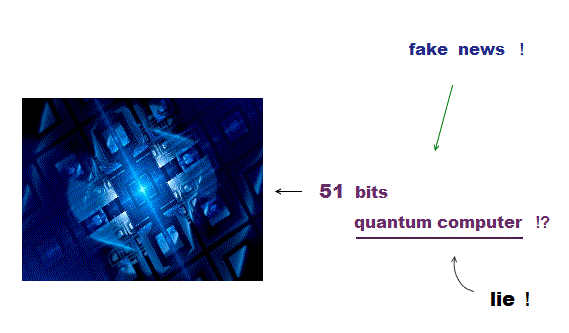
For example, the geometry optimization took extremely much time = a week for this impractical quantum mechanical SCF to calculate some small molecular energy observed by the atomic force microscope (= AFM ) with only one tip. ↓
This-p.4-5th-paragraph & p.5-2nd-paragraph-last say
"The
interaction energies of the tip and the sample molecule (without substrate) were
calculated for various lateral positions with a lateral spacing of 0.1 Å and for tip heights
ranging from d = 3.95 Å to d = 3.35 Å with a vertical spacing of 0.025 Å. To obtain the
frequency shifts (= Δf, p.3-top ), the interaction energies were numerically differentiated twice with
respect to d"
"The calculation of the Δf(x) line profiles (= frequency f shift or energies calculated by DFT in various different tip positions ) took about a week computation time on a large computer facility. ← too time-consuming, impractical ( this-p.3-1st-paragraph )."
This-p.2-right-1st-paragraph says
"to
explore the topology of the PES (= potential energy surface ) of docosahexaenoic acid (DHA)
With DFT methods, this analysis would require more than a
year of computation time" ← too time-consuming, useless for any applied science, medicine.
Today's only method of simulating motions of the (unreal) quantum mechanical shapeless atoms is the impractically-time-consuming molecular dynamics ( this-p.5-102-sentence says just 50ps molecular motion was simulated, which is impractical ).
We should replace this impractical time-consuming quantum mechanical wavefunction by the much simpler atomic model with experimentally-measured shape for the practical multi-probe atomic force microscopes to clarify complicated proteins at the atomic level and cure diseases.
(Fig.4) The use of many-probe, multi-probe atomic force microscopes can efficiently, speedily generate artificial chemical reactions and desired molecular bonds.

Unlike the useless one probe, atomic force microscopes with multiple probes can observe, analyze, manipulate any forms of molecules and proteins (= in case of a large protein, breaking the protein little by little using artificial molecular bond dissociation through applying voltage enables us to know the precise outer and inner protein structure by the multi-probe atomic force microscope, this or this-p.21 ).
Of course, the practical multi-probe atomic force microscope can design and build useful molecular devices (= used for artificial efficient photosynthesis based on artificial catalysts and curing cancers ) by manipulating single atoms, using realistic atomic model with shape (= instead of the unphysical impractical quantum mechanical shapeless atomic model ).
Efficient speedy chemical reactions forming artificial covalent bonds between the designated atoms of molecules, which are impossible otherwise, are possible using multi-probe atomic force microscopes.
In the process of the speedy artificial chemical (= molecular bond ) reactions, first we deposit distilled pure molecules over a substrate (= by vacuum deposition or something ).
If we put some different marks or narrow lines (< 10nm ) with slightly different heights (or different lengths, widths ) or consisting of different atoms on different positions of the substrate, we can know the positions of each probe (and deposited molecules ) immediately when tips touch the substrate surface.
Next, we can know the positions of target molecules deposited over the substrate by using non-contact (= high-resolution quartz sensor ) atomic force microscope with many probe tips (= each probe can move in z direction independently to detect target molecules with different heights automatically at very high speed. All these many probes are moved together in x,y directions ).
↑ A probe tip can be moved (= displaced ) up to the distance of 0.1% of the piezo electric material (= actuator ), so moving atoms 1μm needs 1mm piezo electric material ( this p.3-left, this 4~6th-paragraphs ).
↑ Moving each probe of many probes in x-y directions independently needs much space of the piezo material (= 1mm × 1mm ) in each probe, while moving each probe only in z direction independently does not need so much space (= just tiny 1μm × 1μm space in x,y directions is OK ), which can increase the dense of probes (= many compact probe tips ) and speed up the atomic force microscope finding all target molecules deposited over the substrate.
After knowing the positions of target molecules on the substrate by many probes, we can move those molecules by an atomic force microscope with multiple probes (= manipulating single molecules freely in x,y,z directions ) from the substrate to some designated places where many artificial covalent bonds can be formed simultaneously by applying voltages between two molecules placed on designated positions.
As a result, the fast, practical mass production of artificial molecules with desired covalent bonds (= which are impossible in other ways ) is possible in the atomic force microscope with multiple probe tips manipulating single molecules.
(Fig.5) Speedy efficient chemical bond formation by nano-plates built by multi-probe atomic force microscopes
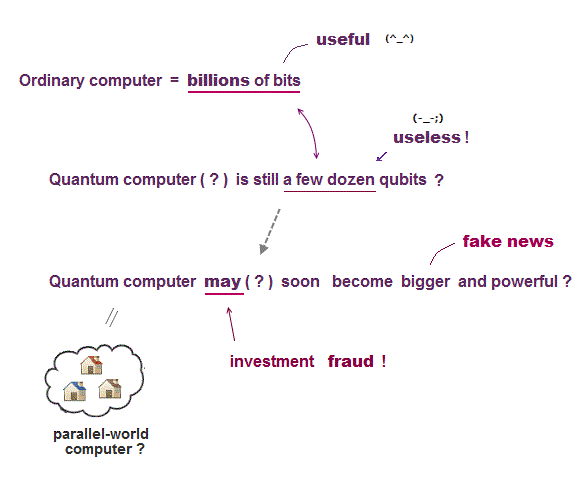
As shown in the upper figure, if we build nano-plates designed to stick to some molecules by multi-probe atomic force microscopes, we can easily and efficiently cause artificial chemical reactions or bonds between some specific molecules by controlling two nano-plates designed to stick some molecules on designated positions and flowing electricity.
↑ These artificial nano-plates or enzymes built by multi-probe atomic force microscopes can be repeatedly used, and kept clean for a long time by using cathodic protection.
By using practical multi-probe atomic force microscopes, we can clarify detailed atomic mechanisms of proteins in various diseases, and design some effective drugs or molecules sticking only to some cancer cells, HIV-infected cells, and auto-immune-antibody-producing cells, and remove them (= after these artificial molecules stick to target sick cells, only these sick cells are prevented from dividing, and eventually die, which can cure the current incurable diseases ).

Feel free to link to this site.